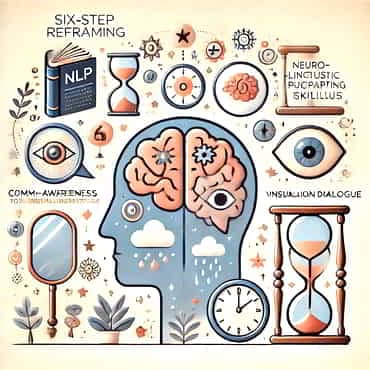Change Behaviour And Keep The Change Using 6-Step Reframing From NLP

Estimated reading time: 8 Min
Here you can develop an understanding of the power of six-step reframing, from NLP and how to use it to change behaviour fast and with lasting effect.
Neuro-Linguistic Programming, or NLP, is a fascinating approach to understanding and improving human behaviour and communication.
Ever since attending three levels of training between 1980 and 1982, which led to a Masters Certificate in NLP, I’ve had a life-long, practical interest in how the brain works.
One of the standout techniques within NLP is six-step reframing, a method designed to help individuals resolve internal conflicts and create positive behavioural changes.
This technique taps into the subconscious mind, allowing you to uncover and take advantage of the underlying intentions behind your actions.
In this post, we’ll explore the origins of 6 Step Reframing, its benefits compared to other methods, what it entails, and the skills needed to effectively use it.
By the end, you’ll have a solid understanding of how this powerful tool can help you make meaningful changes in your life.
Origins of 6-Step Reframing
The story of six-step reframing begins with the development of Neuro-linguistic Programming in the 1970s.
Richard Bandler and John Grinder founded NLP with the goal of figuring out the best communication and behaviour patterns based on the way that our language and neurology affect each other.
Their work led to the formulation of various techniques useful for improving personal and professional lives.
Six-step reframing emerged as part of their broader efforts to decode how the mind works and how we can influence our behaviours positively.
Initially applied in therapeutic settings, this technique gained popularity for its effectiveness in addressing a wide range of issues, from habits and emotional responses to limiting beliefs.
Over time, six-step reframing has been refined and adapted, but its core principles remain rooted in the early work of Bandler and Grinder.
Benefits of 6-Step Reframing Compared to Other Methods
When it comes to personal development and behavioural change, there are numerous methods available.
However, six-step reframing stands out for several reasons:
Speed and Effectiveness
Unlike traditional therapy, which can take months or even years to yield results, six-step reframing often produces noticeable changes much more quickly.
By directly engaging the subconscious mind, this technique can bypass many of the conscious barriers that slow down progress.
Focus on Positive Intentions
Many other approaches focus solely on eliminating negative behaviours without understanding their underlying causes.
Six-step reframing, however, seeks to uncover the positive intention behind every behaviour, ensuring that the change is both constructive and sustainable.
Versatility
This technique is incredibly versatile and applicable to a wide range of issues.
Whether you’re dealing with a bad habit, an emotional response, or a limiting belief, six-step reframing can help you identify and implement positive alternatives.
Holistic Approach
Six-step reframing integrates new behaviours into your life, making the changes more natural and long-lasting.
This holistic approach ensures that the new behaviours align with your overall goals and values.
Understanding 6-Step Reframing
To fully grasp the power of six-step reframing, it’s important to understand what it is and the principles behind it.
Definition and Basic Concept
Six-step reframing, as an NLP technique, involves communicating with the subconscious mind to identify and change unwanted behaviours.
The idea is that every behaviour, no matter how problematic it seems, serves a positive purpose or intention.
By understanding this positive intention, you can find healthier ways to achieve the same goal.
Core Principles of NLP
- The Unconscious Mind
NLP recognises that much of our behaviour is driven by the unconscious mind, which holds our habits, memories, and emotions. By engaging with this part of the mind, we can access deeper insights and make more effective changes. - Positive Intention
A fundamental principle in NLP is that every behaviour has a positive intention. Even behaviours that seem negative or self-destructive are attempting to fulfil a positive need or purpose. Recognising this intention allows for more compassionate and effective change.
In essence, six-step reframing helps you connect with your subconscious mind, understand the positive intentions behind your behaviours, and find new, healthier ways to achieve those intentions.
This process not only resolves internal conflicts but is also the catalyst for lasting, positive change.
Skills Needed to Use 6-Step Reframing
Successfully applying six-step reframing requires a set of specific skills.
Here’s what you’ll need:
Basic Understanding of NLP Concepts

Familiarity with the principles of NLP, such as the role of the subconscious mind and the idea of positive intentions behind behaviours, will provide a strong foundation.
Self-Awareness and Introspection
Being able to reflect on your thoughts, feelings, and behaviours is crucial.
This self-awareness allows you to accurately identify the behaviours you want to change.
Communication Skills (Internal Dialogue)
Since six-step reframing involves communicating with different parts of your subconscious mind, strong internal dialogue skills are essential.
This means being able to ask yourself questions and listen to your inner responses.
Visualisation Techniques
Visualisation helps in imagining new behaviours and seeing yourself successfully implementing them.
This mental rehearsal can make the transition to new behaviours smoother.
Practice and Patience
Like any skill, mastering six-step reframing takes time and practice.
Being patient with yourself as you learn and apply the technique will increase your chances of success.
The 6-Step Reframing Process
Now, let’s go through the actual process of six-step reframing.
Follow these steps to implement the technique:
Step 1: Identify the Behaviour
- Begin by pinpointing the specific behaviour you want to change. This could be a habit, an emotional reaction, or a limiting belief.
- Example: You want to stop procrastinating on important tasks.
Step 2: Establish Communication with the Part
- Close your eyes and focus on the behaviour. Ask yourself, “What part of me is responsible for this behaviour?”
- Wait for an internal response, which could be a sensation, a feeling, or an inner voice.
Step 3: Discover the Positive Intention
- Ask the part, “What positive purpose does this behaviour serve?”
- Understand that even negative behaviours aim to fulfil a positive need.
- Example: Procrastination might be a way to avoid stress or fear of failure.
Step 4: Generate Alternative Behaviours
- Brainstorm new behaviours that can achieve the same positive intention but in a more constructive manner.
- Ask the part, “What other ways can achieve this positive purpose without the negative consequences?”
- Visualise or list out possible alternatives.
Step 5: Obtain Agreement from the Part
- Ensure that the Part responsible for the behaviour agrees to try the new alternatives.
- Internally communicate with the part, asking if it’s willing to adopt these new behaviours. You should feel a sense of agreement or positive response.
Step 6: Integrate the New Behaviour
- Imagine yourself using these new responses in various situations.
- In your mind’s eye, imagine scenarios where you would typically engage in the old behaviour but now see yourself using the new, positive alternatives.
Real-life Examples
These examples are derived from real-life applications of the six-step reframing technique, demonstrating its practical use in overcoming various challenges by addressing the underlying positive intentions of behaviours.
Case Study 1: Overcoming Fear of Public Speaking
A client struggled with intense anxiety about public speaking.
Using six-step reframing, they identified the part of them that was causing the anxiety.
The positive intention behind this fear was to protect the client from embarrassment and failure.
By acknowledging this intention, the client and therapist worked together to find alternative behaviours, such as practicing relaxation techniques and preparing thoroughly for presentations.
The client agreed to try these new strategies, and over time, their anxiety significantly decreased, allowing them to speak confidently in public settings (NLP Comprehensive).
Case Study 2: Reducing Smoking Habits
Another documented case involves a client who wanted to quit smoking.
Through six-step reframing, the client discovered that the part of them that smoked was trying to provide stress relief and moments of relaxation.
By exploring healthier alternatives, such as taking short walks or practicing deep breathing exercises, the client was able to replace the smoking habit with these new behaviours.
This reframing process led to a successful reduction in smoking and improved overall well-being (NLP Mentor).
FAQs: Change Behaviour And Keep The Change
How long does it take to see results with 6-Step Reframing?
Results can vary. Some people notice immediate changes, while for others, it might take a few weeks of consistent practice.
Can 6-Step Reframing be used for any behaviour?
Yes, it can be applied to a wide range of behaviours, from habits and emotional responses to limiting beliefs.
Do I need a practitioner to guide me through the process?
While having an NLP practitioner can be helpful, many people successfully use this technique on their own with proper understanding and practice.
What if I don’t get a clear response from the part of me responsible for the behaviour?
Be patient and give yourself time. Practice relaxation techniques and keep trying. Sometimes, the subconscious mind needs time to reveal itself.
Can I use 6-Step Reframing for positive behaviours too?
Yes, it’s not just for changing negative behaviours. You can use it to enhance or modify positive behaviours for even better outcomes.
Summary
Six-step reframing is a powerful NLP technique that can help you make meaningful changes by addressing the underlying positive intentions behind your behaviours.
By following this structured process, you can replace negative habits with positive ones and achieve a more balanced, fulfilling life.
Remember, the key is to be patient and persistent, as change takes time and practice.
If you are interested in learning more about Neuro-linguistic Programming, see “Useful Resources” below.
In the meantime, if you have anything to add or ask, then please use the comments or the contact form.
😉
Richard
Useful Resources
Books:
- “Frogs into Princes” by Richard Bandler and John Grinder
- “The Structure of Magic” by Richard Bandler and John Grinder
- “Reframing: Neuro-Linguistic Programming and the Transformation of Meaning” by Richard Bandler and John Grinder
Websites:
Courses:
- NLP Practitioner Certification courses (available online and in-person)
- Advanced NLP training workshops






